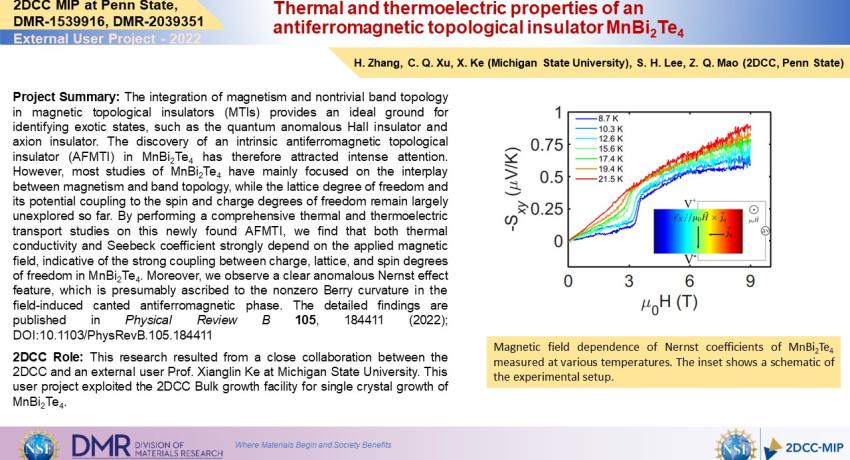Project Summary: The integration of magnetism and nontrivial band topology in magnetic topological insulators (MTIs) provides an ideal ground for identifying exotic states, such as the quantum anomalous Hall insulator and axion insulator. The discovery of an intrinsic antiferromagnetic topological insulator (AFMTI) in MnBi2Te4 has therefore attracted intense attention. However, most studies of MnBi2Te4 have mainly focused on the interplay between magnetism and band topology, while the lattice degree of freedom and its potential coupling to the spin and charge degrees of freedom remain largely unexplored so far. By performing a comprehensive thermal and thermoelectric transport studies on this newly found AFMTI, we find that both thermal conductivity and Seebeck coefficient strongly depend on the applied magnetic field, indicative of the strong coupling between charge, lattice, and spin degrees of freedom in MnBi2Te4. Moreover, we observe a clear anomalous Nernst effect feature, which is presumably ascribed to the nonzero Berry curvature in the field-induced canted antiferromagnetic phase. The detailed findings are published in Physical Review B 105, 184411 (2022); DOI:10.1103/PhysRevB.105.184411
2DCC Role: This research resulted from a close collaboration between the 2DCC and an external user Prof. Xianglin Ke at Michigan State University. This user project exploited the 2DCC Bulk growth facility for single crystal growth of MnBi2Te4.
What Has Been Achieved: Measurements on the temperature and magnetic field dependences of its resistivity, thermal conductivity, and Seebeck coefficient reveal strong coupling between charge, lattice, and spin degrees of freedom in the intrinsic antiferromagnetic topological insulator MnBi2Te4. Furthermore, MnBi2Te4 is found to exhibit a large anomalous Nernst signal.
Importance of the Achievement: The results revealed through this work deepen the understanding of the interplay between magnetism, electronic structure and band topology.
Unique Feature(s) of the MIP that Enabled this Achievement: Synthesis of high-quality MnBi2Te4 single crystals are extremely challenging due to the disorders caused by its non-stoichiometry compositions. The 2DCC has developed a protocol to grow MnBi2Te4 single crystals with good quality. This work was inspired by the 2DCC in-house research on MnBi2Te4 and other related materials.
(If Applicable) Publication:
H. Zhang, C. Q. Xu, S. H. Lee, Z. Q. Mao, and X. Ke, Physical Review B 105, 184411 (2022). DOI:10.1103/PhysRevB.105.184411
Acknowledgements: H.Z. and X.K. acknowledge the financial support by the U.S. Department of Energy, Office of Science, Office of Basic Energy Sciences, Materials Sciences and Engineering Division under DE-SC0019259. C.Q.X. is partially supported by the Start-up funds at Michigan State University. The financial support for sample preparation was provided by the National Science Foundation through the Penn State 2D Crystal Consortium-Materials Innovation Platform (2DCC-MIP) under NSF Cooperative Agreement No. DMR-1539916 and No. 2039351.
